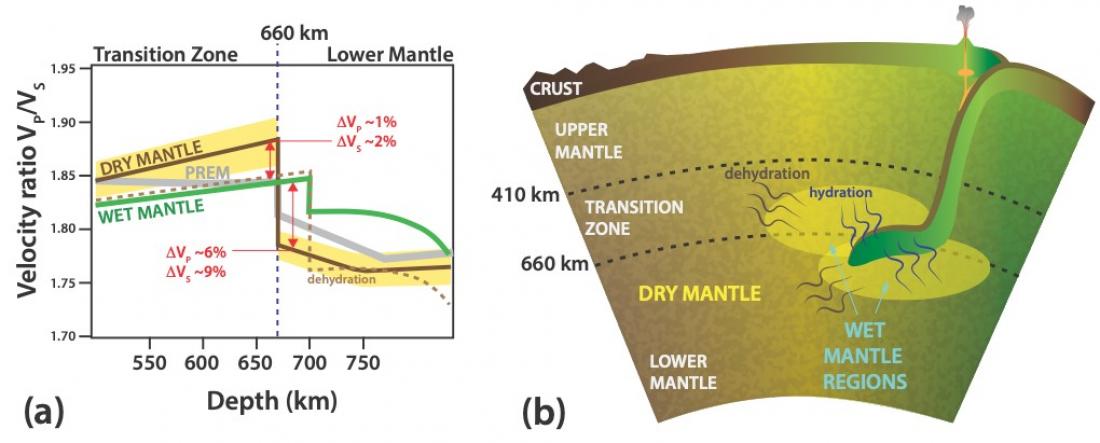(a) Velocity ratio VP/VS of the hydrated mantle regions compared to that of the dry mantle along hot and cold mantle temperature profiles. (b) Hypothetical scenario of the subducted slab delivering water to the mantle transition zone and uppermost lower mantle. The mantle is hydrated upon release of water during the full or partial equilibration of the slab with the surrounding mantle.
The discovery of hydrous ringwoodite inclusion in diamonds with 1.5 wt.% H2O by Pearson et al. in 2014, provided an irrefutable indication that water is present in the Earth’s deep mantle. Whether this water was delivered by one of the numerous subducted slabs observed by seismological studies (Fukao et al., Annu.Rev.EPS 2009), or whether it appeared right after the crystallization of the Earth’s mantle from a magma ocean, and the total budget of water in the Earth’s interior are all still up for debate. Petrological studies have shown that water, when present in the deep mantle, can either incorporate existing minerals (Inoue et al., PEPI 2010; Pearson et al., Nature 2014), form dense hydrous mineral phases (Pamato et al., Nat.Geo. 2016; Nishi et al., Nat.Geo. 2016) or promote partial melting by decreasing the melting point (e.g. dehydration melting) of mantle rock. Which process is dominant is still not very well understood because of the difficulty of synthesizing adequate water-bearing minerals for laboratory measurements and hence sound velocity data for hydrous minerals is scarce, which limits comparisons with seismological observations.
In this context, a research team at Ehime University decided to investigate a mineral called Superhydrous phase B (SuB), which is proposed to be one of the most abundant of the dense hydrous minerals and an important deposit site of water in the in the mantle transition zone (MTZ, 410–660 km in depth) and upper lower mantle (ULM, 660–800 km in depth). A few studies have reported the sound velocities of SuB, but their data were limited to room temperature, which poorly constrained the elasticity of this phase at the P and T conditions of the deep mantle. The researchers at Ehime first synthesized a polycrystalline body of SuB at high pressure using the multianvil apparatus at the Geodynamics Research Center. They then transported their SuB sample to the synchrotron facility SPring-8, located in Hyogo (Japan), where they investigated its sound velocities up to 21 GPa and 900 K using ultrasonic interferometry combined with synchrotron X-ray techniques at the beamline BL04B1.
The results of their experiments showed the compressional (VP) and shear velocities (VS) of SuB are particularly low compared to other deep mantle minerals. Only majorite garnet, a mineral also investigated by their group (Irifune et al., Nature 2008; Zhou et al., GRL 2021), has velocities lower than SuB at the P and T conditions of the MTZ. Based on their new data they estimated the velocities and density of a hypothetical hydrated mantle, where SuB is present as the main water carrier, and compared their results with a dry mantle along cold and hot temperature profiles. From these models they showed that cold hydrated mantle regions would be characterized by seismically detectable negative P- and S-wave anomalies at multiple depths in the MTZ and ULM, such as those observed in cold subduction zones beneath northeast Japan and Tonga. Their results further suggested that the presence of hydrated mantle in the ULM could explain local large negative P- and S-waves as well as density anomalies at depths of 670–700 km, such as those observed beneath 660km by seismological studies. These new data should greatly contribute to tracing the existence of water-bearing rocks in the deep mantle and eventually give more accurate estimates of the water budget of the Earth’s lower mantle.



